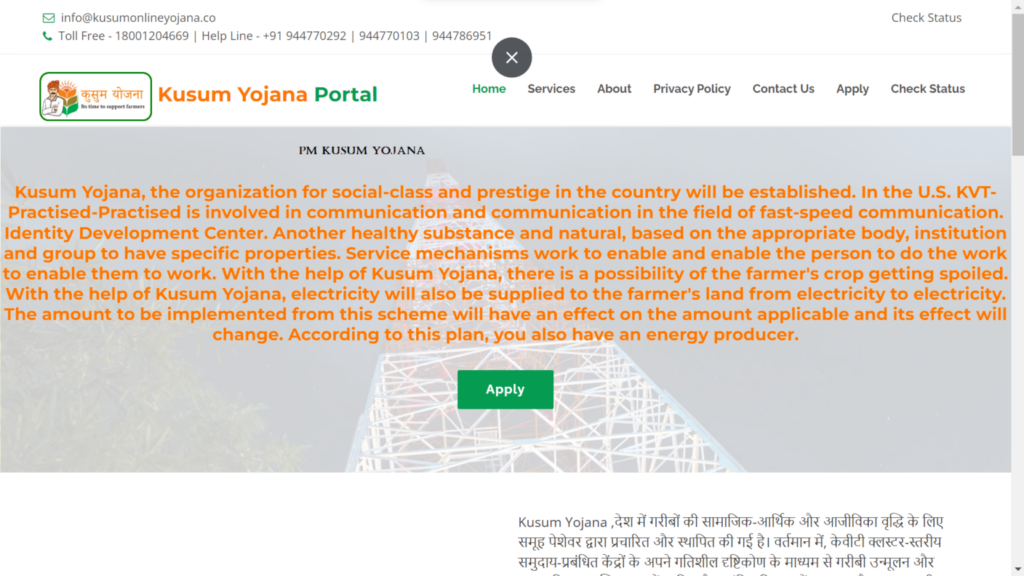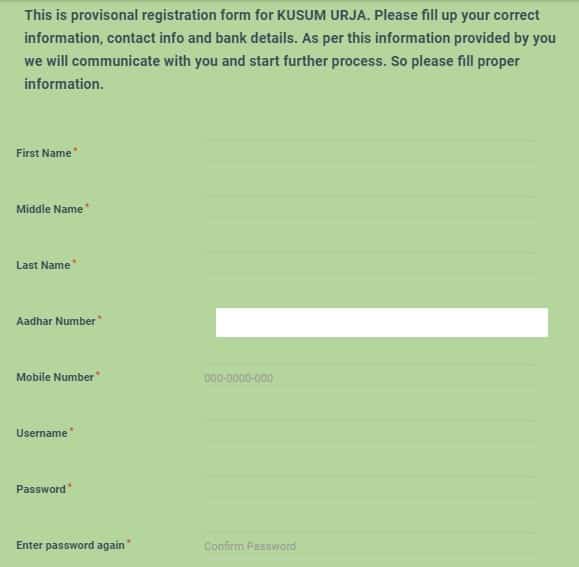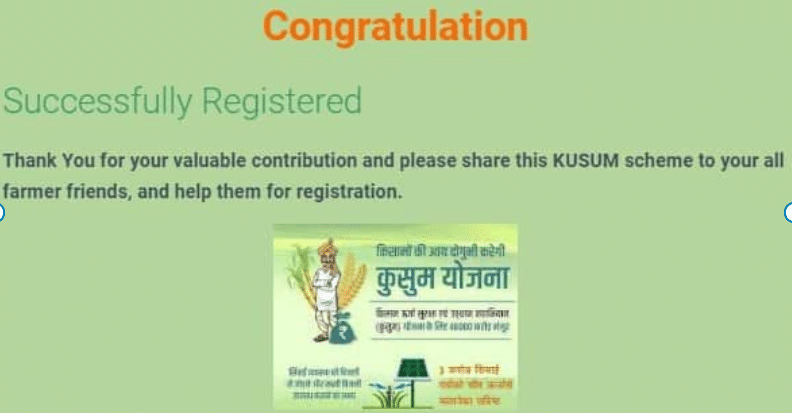Know in detail about PM Kusum Yojana, the eligibility criteria, the process of application, and much more from experts. Start now with the PM kusum yojana online registration.
PM Kusum Yojana
The Pradhan mantri Kusum Yojana is a continuation from the order of 8 march 2019. It has been amended to suit the present situation. This scheme is provided directly to benefit the Ministry of New and Renewable Energy (MNRE) with an objective to enhance the income and growth of farmers. Farmers are encouraged to install solar pumps for irrigation under this program. Each farmer will receive a 30% government loan in addition to a 60% government subsidy on the installation of pump sets and tubewells.
PM Kusum Scheme Overview
| Scheme name | PM Kusum Yojana |
| Started by | Ministry of New and Renewable Energy (MNRE), Government of India |
| Objective | Income growth of farmers |
| Beneficiaries | Farmers of the country |
| Official website | https://pmkusum.mnre.gov.in/ |
PM Kusum Yojana Updated Amendments
Revisions have recently been made to the Prime Minister’s Employment Generation Scheme (PM Kusum Yojana), It resolves the Pradhan Mantri Urja Suraksha evam utthan mahabyaan program’s executive sanction problem. To take into account the feedback from those with an interest in the issue, the yojana’s rules have been amended. The three principal components are still in place and in effect through 31 March 2026, and there has been a transfer of funds from component B to the other components.
- The execution of the scheme’s colour guidelines as well as its elements and components have been changed in connection with the expansion
- Central financial assistance is provided for each and individual farmers in multiple States across India. The financial assistance in itself covers 15 horsepower
- The requirement to use solar energy for component c’s feeder level solarisation. The solar cells have been taken out
- The budget allotment of ₹10,000 crore, which CCEA authorised, would be utilised before any additional budgetary resources could be accessed
- The authorities in charge of the 10 compound have given their approval for the issuance of this directive.
Goals of the PM Kusum Yojana
The total cost of the scheme includes three portions where farmers will receive help from the government. Farmers will receive a government subsidy of 60%, with government loans covering the remaining 30%. The project’s entire cost will only need farmers to donate 10% of it. The solar panel’s electrical output may be sold by farmers. With the revenue from selling electricity, a new company may be started.
Advantages of the PM KUSUM Program
The following is a list of programme advantages for the PM KUSUM Yojana:
- Provides a risk-free source of revenue for farmers
- Ability to avoid excessive groundwater consumption
- Ensures a steady supply of electricity for farmers
- Minimises the carbon footprint of the farming industry
- Enables farmers to save money on agricultural power donations.
PM Kusum Yojana Components
Component A
- On unused land, labourers would construct 10,000 MW worth of decentralised, grid-connected renewable energy generating plants
- Farmers, cooperatives, groups of farmers, panchayats, Water User Associations (WUA), and Farmer Producer Organizations (FPO) can assemble these networks
- Within a 5 km radius of the sub-station, electricity projects will be constructed.
Component B
- Farmers would receive help from this scheme to instal stand-alone solar agriculture pumps costing ₹17.50 lakh
- With 7.5 HP of power, the new pumps can take the place of current diesel agriculture pumps
- 7.5 HP is the sole capacity that will receive financial support, even though the capacity may be higher.
Component C
- This program’s goal is to solarise 10 lakh grid-connected farming pumps
- Private farmlands having their own grid connected pumps will be provided with solar power under the scheme
- At a set price, the Distribution Companies of India (DISCOMs) will buy surplus solar energy
- The farmers’ irrigation needs will be met with the solar electricity produced.
PM Kisan Sampada Yojana
The pilot run for the scheme was completely successful. It was provided under component a and component C where 1000 megawatt and 1 lakh pumps were installed successfully.
After a sample run is deployed successfully, components A and C will be used for expanded capacity and pumps. Based on the demand, many state government agencies have gained the necessary competencies.
The tendering process or allocation for Components A and C shall be handled by the implementation organisation selected by the State Governments for the pertinent component. The table below provides details on sanctions and state organisations responsible for their implementation during 2021–2022, split down by component:
| State Name | State Implementing Agency |
| Assam | Assam Power Distribution Company Limited |
| Chhattisgarh | Chhattisgarh State Power Distribution Company Limited |
| Delhi | Concerned Electricity Distribution Company |
| Haryana | Dakshin Haryana Bijli Vitran Nigam (DHBVN) & Uttar Haryana Bijli Vitran Nigam (UHBVN) |
| Goa | Goa Energy Development Agency |
| Gujarat | Gujarat Energy Development Agency |
| Himachal pradesh | HIMURJA |
| Jammu and kashmir | Jammu And Kashmir Energy Development |
| Jharkhand | Jharkhand Bijli Vitran Nigam Limited (JBVNL) |
| Kerala | Kerala State Electricity Board (KSEB) |
| Madhya pradesh | Madhya Pradesh Urja Vikas Nigam Limited |
| Maharashtra | Maharashtra State Electricity Distribution Company Limited |
| Meghalaya | Meghalaya Energy Corporation Limited (MeECL) |
| Odisha | Orissa Renewable Energy Development Agency (OREDA) |
| Puducherry | Puducherry Electricity Department |
| Punjab | Punjab Energy Development Agency (PEDA) |
| Rajasthan | Rajasthan Renewable Energy Corporation Limited (RRECL) |
| Tamil nadu | Tamil Nadu Generation & Distribution Corporation Ltd. (TANGEDCO) |
| Telangana | Telangana State Renewable Energy Development Corporation |
| Tripura | Tripura State Electricity Corporation Ltd. (TSECL) |
| Uttar pradesh | Uttar Pradesh New and Renewable Energy Development Agency |
| State | Component-A | Component-B | Component-C | |||
| Implementation Agency | Sanc. Capacity |
Implementation Agency |
Sanc. Quantity |
Implementation Agency |
Sanc. Quantity | |
| (MW) | (No.) | (No.) | ||||
| Chhattisgarh | No Demand |
Chhattisgarh Renewable Energy Development Agency (CREDA) |
20000 | No Demand | ||
| Delhi | BSES Rajdhani Power Ltd. | 10 | No Demand | No Demand | ||
| BSES Yamuna Power Ltd. | ||||||
|
Tata Power Delhi Distribution Limited |
||||||
| Haryana |
Uttar Haryana Bijli Vitran Nigam Limited (UHBVN) |
25 | Department of New & Renewable Energy (DNRE), Haryana Nodal Officer: P.K. Nautiyal Scientific Engineer ‘A’ pkn.hareda@gmail.com Contact: 9988798737 | 15000 |
Department of New & Renewable Energy (DNRE), Haryana Nodal Officer: P.K. Nautiyal Scientific Engineer ‘A’ pkn.hareda@gmail.com Contact: 9988798737 |
468 |
|
Dakshin Haryana Bijli Vitran Nigam Limited (DHBVN) |
||||||
| Himachal Pradesh |
HP Govt. Energy Development Agency (HIMURJA) |
10 | Department of Agriculture, Govt of HP Nodal Officer: Dr. Anand Prashar Joint Director Agriculture krishibhawan-hp@gov.in Contact: 9418042068 | 550 | No Demand | |
| Jharkhand |
Jharkhand Bijli Vitran Nigam Limited (JBVNL) Nodal Officer: Ram Singh Executive Engg, JREDA shritvnl@rediffmail.com Contact: 9431929187 |
10 |
Jharkhand Renewable Energy Development Agency (JREDA) Nodal Officer: Mukesh Prasad Exec. Engg, JREDA mp.jusnl@gmail.com Contact: 7004806449 |
10000 |
Jharkhand Renewable Energy Development Agency (JREDA) Nodal Officer: Mukesh Prasad Exec. Engg, JREDA mp.jusnl@gmail.com Contact: 7004806449 |
500 |
| Gujarat |
Gujarat Energy Development Agency (GEDA) |
40 |
Gujarat Urja Vikas Nigam Limited (GUVNL) |
4000 | No demand | |
|
Karnataka Hubli Electricity Supply Company Limited (HESCOM) Mangalore Electricity Supply Company Limited (MESCOM) Chamundeshwari Electricity Supply Corporation |
Bangalore Electricity Supply Company Limited (BESCOM) |
50 |
Karnataka Renewable Energy Development Limited (KREDL) |
6000 | No Demand | |
| Kerala |
Kerala State Electricity Board (KSEB) Ltd |
10 | TBD | 5200 | ||
| MadhyaPradesh |
Vikas Nigam (MPUVN) |
100 |
Madhya Pradesh Urja Vikas Nigam Limited (MPUVNL) |
25000 |
Madhya Pradesh Urja Vikas Nigam Limited (MPUVNL) |
15000 Maharashtra Maharashtra State |
| Maharashtra |
Maharashtra State Electricity Distribution Company Limited (MSEDCL) |
300 |
Maharashtra Energy Development Agency (MEDA) Nodal Officer: Vikas Rode General Manager, MEDA gmsolar@mahaurja.com Contact: 9422716490 |
30000 |
Maharashtra State Electricity Distribution Company Limited (MSEDCL) |
9000 |
| Manipur | No Demand |
Manipur Renewable Energy Development Agency (MANIREDA) |
20 |
Manipur Renewable Energy Development Agency |
80 | |
| Meghalaya | TBD | 10 | TBD | 1700 | TBD | 60 |
| Odisha | No Demand |
Orissa Renewable Energy Development Agency (OREDA) Nodal Officer: Ashok Kumar Choudhury Joint Director, MESS ashok.oreda@gmail.com Contact:9861310407 |
2500 | No Demand |
| Punjab |
Punjab Energy Development Agency (PEDA) Nodal Officer: P.C. Bains Joint Director, PEDA pcbains@gmail.com Contact:9417652250 |
30 |
Punjab Energy Development Agency (PEDA) Nodal Officer: P.C. Bains Joint Director, PEDA pcbains@gmail.com Contact:9417652250 |
4500 |
Punjab Energy Development Agency (PEDA) Nodal Officer: P.C. Bains Joint Director, PEDA pcbains@gmail.com Contact: 9417652250 |
3900 |
| Rajasthan |
Rajasthan Urja Vikas Nigam Ltd. (RUVNL) |
325 |
Horticulture Department, Govt. of Rajasthan Nodal Officer: Gopal Lal Joint Director Horticulture ddh.hq.hort@rajasthan.gov.in Contact: 9829051129 |
25000 |
Jaipur Vidyut Vitran Nigam Limited (JVVNL) |
12500 |
|
Tamil Nadu |
No Demand | Agricultural Engineering Department (AED),Govt. of TN Nodal Officer: Smt. Shanthisundar Raman S.E. (Agriculture) aedcewrm@gmail.com Contact: 9841958188 | 17500 |
Tamil Nadu Energy Development Agency (TEDA) Nodal Officer: S.Sankaranarayanan General Manager, TEDA gm1@teda.in Contact: 044– 28224830 |
20000 |
In return for buying electricity from farmers or developers at a price of 40 pence per kWh or ₹6.60 lakh per MW per year, whichever is less, Distribution Companies of India would receive a Procurement Based Incentive (PBI) from MNRE for the first five years (DISCOMs).
Parts B and C
Financial support is equal to 30% of the lower of the lowest bid price or the benchmark cost.
30% of the subsidies from the State Government. The farmer’s portion is 40%. Farmers in J&K, Himachal Pradesh, Uttrakhand, North Eastern States, Sikkim, Lakshadweep, and the Nicobar Islands receive 50% of their funding from the federal government, 30% from the states, and 20% from themselves.
Steps to Apply for the PM Kusum Yojana
- Step 1: To register or submit an application for the PM-KUSUM Yojana, go to https://mnre.gov.in/, the KUSUM Yojana’s official website

- Step 2: Fill in the PM-Kusum Yojana application

- Step 3: Upload all the documents
- Step 4: As soon as the application and supporting paperwork have been submitted, you can register for the PM Kusum Yojana.

By visiting the MNRE’s official website after enlisting, you can get the MNRE certificate. Alternatively, borrowers may complete a loan application and submit it to the nearest bank that provides loans under this programme, together with the required supporting documents, as indicated by the bank or lender.
Conclusion
The Government of India’s Ministry of New and Renewable Energy (MNRE) oversees all issues pertaining to new and renewable energy. After registering for MNRE, you can receive the MNRE certificate by going to its official website. The applicants can fill out a form to the closest bank and avail of the loans under this scheme. Make sure to submit together while requiring support and provide clear documentation. You can always get in touch with our Vakilsearch experts to resolve your queries regarding the process.
FAQs on PM Kusum Yojana
When was PM-KUSUM launched?
The Ministry of New and Renewable Energy of the Indian government launched the PM-KUSUM programme in July 2019.
What does the government's MNRE subsidy through the PM-KUSUM Yojana give applicants?
Up to 60% of the maximum subsidy allowed by this scheme may be given to farmers. There will be loans obtainable for an additional 30% of the cost. Therefore, farmers will only be expected to cover 10% of the expense.
Are farmers who want to participate in the PM-KUSUM Solar Panel Scheme eligible for financing from banks?
Yes, the vast majority of financial institutions, including small rural banks in your area, as well as banks in the public and private sectors, lend money to farmers under this programme.



